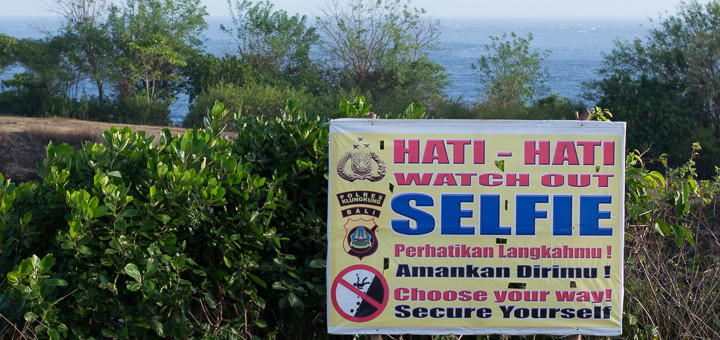“No Selfie” Signs Are a Thing Now
Indonesia as a nation is not known for its vigorous approach to health and safety. Over years exploring the country, I’ve seen motorbikes carry five people (plus baggage), miners head underground barefoot, more helmetless activities than you can shake a stick at, and precisely one speed limit sign (on a toll road).
I was, therefore, a little surprised to see this handy sign atop Broken Bay, a truly dramatic circular sea-cliff in Nusa Penida:

There was a sibling sign at the attraction next door, Angel’s Billabong, a series of natural infinity pools which step down a little gorge towards the ocean. One person was injured and one killed here after a wave hit a group while taking a “wefie” in March, and swept two out to sea. The same thing happened in June last year to a bride, her brand new husband and her 8-year-old sister: both the woman and the little girl drowned.
So, I have to say, the selfie sign makes sense. Angel’s Billabong looks deceptively safe in most sea conditions. It’s not obvious that freak waves could come up. And you can’t expect tourists to know that the currents in the ocean themselves are horrific and that once you’re out there you’re essentially reliant on fishermen and dive boats, regardless what travel insurance you have.
I was less sure about the selfie sign at Broken Bay (although once you’ve printed one, you might as well put up a second one to be sure). Are there really people who don’t look behind them when taking selfies atop a 30-odd-metre cliff?
Apparently so. 25% of 127 recorded selfie deaths worldwide (a statistic we can safely assume is only the tip of a veritable iceberg of stupidity) take place at dangerous heights, such as atop cliffs, mountains or rooftops. Well over half the world’s recorded selfie deaths happened in India, where Mumbai has enforced no-selfie zones since 2016.
The Russians are not far behind. Their police issued a brochure warning of the dangers of selfies on trains, railway lines, water and rooftops, with weapons and/or dangerous animals, or, of course, while holding power cables. (You can insert your own “death in custody” joke here.)
In less charitable times, death by taking a selfie with charging bulls, a loaded gun, a live grenade or an oncoming train might have been written off, like the guys who posed for selfies with a wild elephant, simply as candidates for the Darwin Awards. Today, it seems, they merit their own signs.
As a development, I’m not entirely sure about this. I find it irritating enough when beautiful views are spoiled with heart-shaped frames or love-seats or stairs to heaven for Instagrammers – this may be an Indonesian problem, or it may be more global (let me know if this is a thing where you are!). But if every attractive – yet potentially lethal – vista is to be visually polluted with signs warning folk not to fall off, I’d really rather travel back to the era when self-portraits meant balancing a camera on a rock and setting the self-timer.
And, yes, I know I’m getting old.
